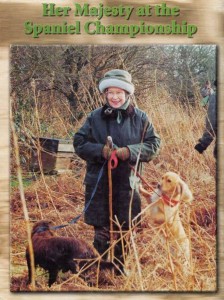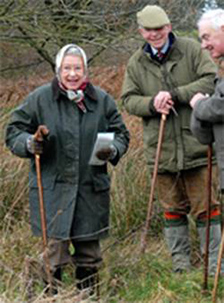Training Spaniels for Blind Retrieves
( published in Spaniels In The Field – winter 1999 )
Often times a dog is working a bird in heavy cover when the bird volunteers and comes out without the dog ever seeing it. When the bird is shot the dog may not have a clue where the bird fell. It is very useful to have your dog ready to handle these situations so that we can recover all of our shot birds. Another situation may arise when the dog is sent on retrieve and flushes a bird out of gun range before he even gets to the fall. With this scenario in mind, the dog may want to go for that healthy flushed bird and forget about the dead bird we have down. The following training routines may help us through these difficult hunting situations.
Pattern Blinds
Pattern blinds are confidence builders. They rely on the fact that the dog knows not only that there is a bird out there but he knows exactly where it is. They should be performed in at least 3 different training areas in at least 3 diferent locations in each area. Locations should all differ in terms of cover such as light cover and thick cover terrain such as up hill, down hill, across a hill, and should contain obstacles such as dirt roads, brooks, stone walls, broken cover.
– Using diagram a. as a reference,
– walk your dog from point “A” to point “B”.
– Then walk toward point “X”
– Leave the dog at hup somewhere between point “B” and point “X”
– Throw a dead bird or a retrieving bumper to point “X”
– Make sure the dog has seen you throw it.
– Walk the dog back to point “B” then to point “A” •
– Walk the dog from point “A” to point “Z”
– Give your dog the command “dead bird” and line the dog to point “X”
There are some important things that we want to achieve through this exercise.We want the dog to go out with the same confidence they have as when they mark a fall. We want to condition the dog to the fact that when we tell them “dead bird” and line them to an area, there is a bird out there. An important thing we must avoid is having the dog follow our trail to the bird. This is why we must go from one point to the next. Be sure to change the location of the pattern blind from day to day. It is good to keep notes as to where you perform this training and how the dog performs. If the dog starts to go, then stops and looks for direction “pops”, then make the distance from point “Z” to point “X” shorter. If the dog is running with confidence out to point “X” , extend the distance. When you extend or decrease the distance from point “Z” to point “X” do it in steps of 20 to 25 yards. Extending distances too quickly could confuse your dog. I will try to get the dogs to eventually go 100 to 150 yards. I only give my dogs 1 or 2 pattern blinds in two different locations each day until we are ready to go to the next step, “Memory Blinds”.
Memory Blinds
Memory Blinds depend on the fact that our dogs have gotten familiar with going to an area and finding a bird when we tell them “dead bird” and line them to that area. Memory blinds also depend on the fact that a dog becomes familiar with the areas we have given them pattern blinds. To make a transition from pattern blinds to memory blinds we must use the same areas that we used for pattern blinds. The dog has been rewarded in these areas and will trust you more readily. To make the transition to “Memory Blinds” we perform the same steps as above except, we no longer allow the dog to see us put the bird at point”X”. It is a good idea to begin with a short distance and gradually increase the distance between points “Z” and “X”. Again keep notes as to the dog’s progress and the areas you train in. At first the dog may be confused and hesitate to go when sent. If this happens, remain calm and just keep decreasing the distance until the dog gets the idea. When the dog is running to the blind with confidence, gradually increase the distance. After your dog is doing consistently well in several of the familiar areas, it is time to move to “Cold Blinds”.
Cold Blinds
Cold blinds are birds the dog did not see fall. They are generally not in areas that the dog has been succesfull in or even familiar with. With cold blinds we are working on the sole fact that when we send the dog, he trusts that there is a bird out there and is familiar with the concept of finding a bird he didn’t see fall. When you set up a cold blind, select an entirely new training area. Place a bird out using the same considerations used in “diagram a” Start with a blind placed at a short distance and gradually increase the distance. If the dog is confused or having a difficult time, decrease the distance until he understands what he’s expected to do.
Some Key Considerations
When doing this training with a spaniel, it is important to remember that we still want our dog to be hunting. We don’t need to have a very straight line. Hunting dogs have a tendency to scoop the wind in search of birds. In a cross wind from right to left, expect that the dog will invariably drift to the left of the line you give them. It’s also natural to see them on a down wind work in an almost circular pattern as they go deeper and deeper down wind in search of a bird. Training on blind retrieves should be done with a down wind or a cross wind.
“T” Training “T”

Training is a good way to introduce distractions with blind retrieves. It is also a good idea to introduce “T” training with Pattern Blinds. Using diagram b, walk the dog at heel from point Z to Point X. Drop a dead bird or a retrieving bumper at point X. Tell the dog ‘leave it’. Then heel the dog half way back to point Z. Throw dead birds or retrieving bumpers to points T1 and T2 telling the dog ‘leave it’ each time. Walk the dog at heel back to point Z. Line the dog to point X. The dog will probably try to go to the last bird thrown to one side of the “T” or if we are training in a cross wind, he will be sucked to the bird on the wind side of the “T”. Do not allow the dog to retrieve either of the birds on the “T”. Stop the dog with a stop whistle and call the dog in when he attemps to go to either side of the “T”. Move the dog closer from point Z to point X and line the dog again to point Z. If he attempts to go to either side of the “T”, stop him again and call him in. Keep moving the dog closer from point Z to point X until he will go all the way to point X and retrieve the dead bird or dummy from there. Realize that as we move the dog closer from point Z to point X, we will eventually eliminate the distractions of the dead birds or dummys on the “T”. This is ok so that we allow the dog to understand that we want him to get the bird at point X. After the dog completes the retrieve from point X, keep repeating this exercise until the dog will retrieve at point X without going to T1 or T2. Essentially, we are sliding the dog along the “T” to get him to go to point Z and avoid the distractions of T1 and T2. When the dog understands and will line from point Z to point X, we can then occasionally begin handling by stopping the dog at or after the “T” and handling the dog over to either T1 or T2, or back to X. It is important that the dog always takes his line to point Z without anticipating being stopped to handle, or popping and looking for direction. To avoid this from happening, only handle the dog once for every 5 or 6 times you line him to X.
Pat has been training professionally for over 14 years. Together with his wife, Holly, they run Hedgerow Kennel and Hunt Club in Royalston, Massachusetts. Training all types of pointing, flushing, and retrieving breeds and their handlers, springers are Pat’s #1 love.



